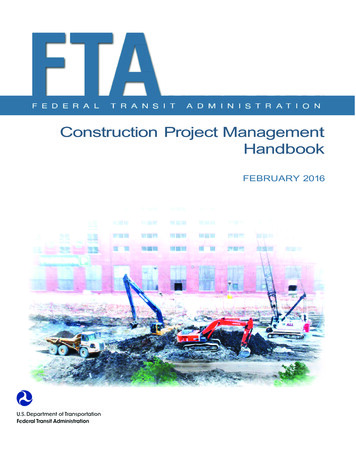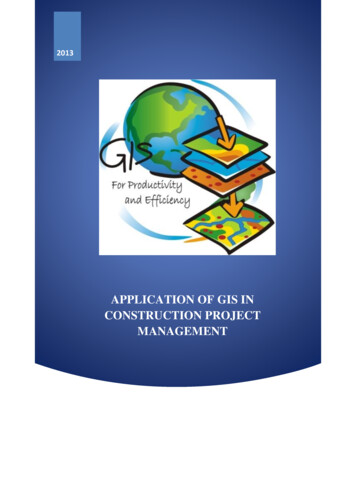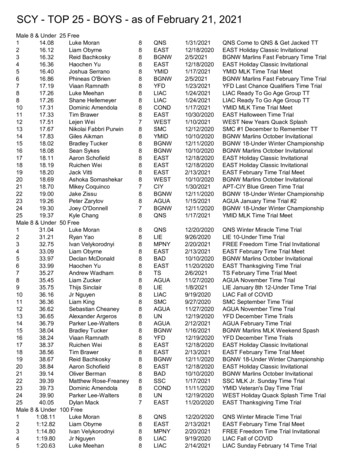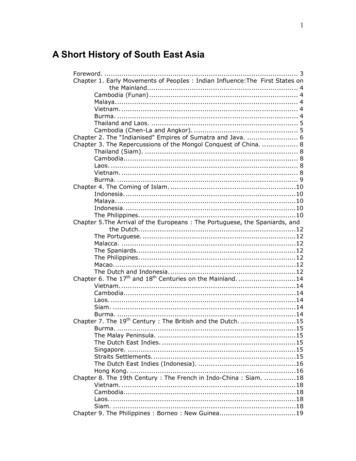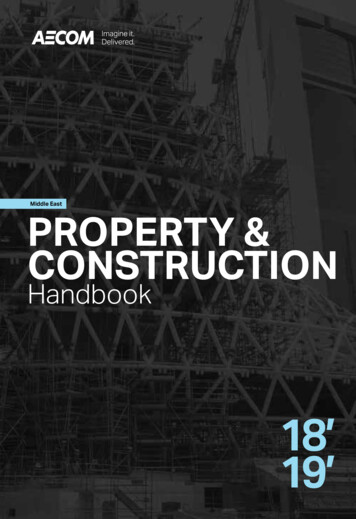
Transcription
Middle EastPROPERTY &CONSTRUCTIONHandbook18’19’1
Middle East Property & Construction Handbook 2018/192
AECOMFOREWORDWelcome to the twelfthedition of the Middle EastProperty & ConstructionHandbook. We hope that youwill find our assessment ofthe trends shaping the globaland regional constructionindustry of interest and thisyear’s selection of articlesand cost data of value.This year, we start off byreviewing the global macroeconomic factors thatcategorized 2017 as a betteryear than 2016 for the worldeconomy; a trend set tocontinue in the near term. Betterthan expected performanceof key markets in Europe andthe US supported an uptickin global economic output in2017 and early 2018. Increasedmanufacturing output in Asiaalso played a part. Sectionone contains a detailed reviewof these markets as well asour anticipated trends for theremainder of 2018 and into 2019.In our articles section weexplore three emerging trendsin the construction market. Wereview the adoption of digitalconstruction tools and examinehow modern constructiontechniques are incorporating3D printing and roboticsinto their work flows. Welook at project managementchallenges, and the role of valueand risk management. Lastlywe share our thoughts on theecology of a city, demonstratinghow it is possible to designcities that complement theirecological environments.If you are new to the MiddleEast construction industry,section three will provide youwith insights into procurementroutes, forms of contract inthe Middle East and buildingregulation and compliance. Ifyou are a veteran in the MiddleEast industry, section three willprovide you with a reminder ofkey contract and regulatoryinformation, a good referenceto keep.The handbook concludeswith our reference section,international and regional costdata and a directory of ouroffices in the region.As with previous years we continue toseek feedback in everything we do.Please contact the editors, Marc Gibbons &Tulsi Patel via bi middleeast@aecom.comfor further information.3
Middle East Property & Construction Handbook 2018/19Lusail ExpresswayAerial view of 5/6 arches at 5/6 InterchangeImage courtesy of AshghalICD Brookfield PlaceImage courtesy of ICD BrookfieldSarat VillageImage courtesy of Diyar Al MuharraqIl PrimoImage courtesy of Emaar4
AECOMContents01020304Economic round up08Global economicreviewArticles40Digital construction74Procurement routes78Middle East formsof contractReference data92100International buildingcost comparison1051100647Project value and riskmanagement trendsin the GCCReference articlesMajor measuredunit rates0515Global constructionprojectsTypical buildingservices standardsfor officesRegional buildingcost comparison106Major materialprices111Exchange rates22MENA economicreview61Ecology of a city83Building regulationsand compliance102Basis ofconstruction costs107Labour costs104Mechanical andelectrical costcomparison108Middle EastIndices112Weights andmeasuresDirectory of offices115Directory of officesFuture of Infrastructure119Future ofInfrastructure survey5
Middle East Property & Construction Handbook 2018/196
AECOM01ECONOMICROUND UPIN BRIEF08Global economicreview15Global constructionprojects22MENA economicreview7
Middle East Property & Construction Handbook 2018/19GLOBALECONOMICREVIEWBetter than expected performanceof key markets in Europe andthe US supported an uptick inglobal economic output in 2017and early 2018. The favorablemarket conditions are likely tocontinue in the near-mediumterm, however downside riskscontinue to outweigh upside risksin the near-medium term outlook.Protectionism, vulnerability offinancial markets and globaltensions are considered the mostsignificant downside risks withinthe outlook.8
AECOMA significant increase in trade levels between 2016and 2017 contributed to the improvement in globaleconomic forecasts for the near term. According tothe World Bank Group, world trade volume increasedby 4.8 percent in 2017 and is expected to grow byanother 4.3 percent in 2018. IMF estimates a growthin exports of advanced economies by 4.2 percentin 2017, well above their growth levels in 2016.The volume of exports in emerging and developingeconomies continued to increase at a higher rate fromtheir 2016 levels. These positive trends are supportedprimarily by increased investment from advancedeconomies and increased manufacturing output inAsia. However, the impact of recent US tariffs may alsofactor in the coming periods.Real GDP growth4.8%6.0%% change y-o-y5.0%4.3%4.0%3.0%2.0%Fig. XX Growth in volume of exports of goods and services1.0%0.0%Fig.Growthin2016volumeof exportsof goods andservicesFig. XX Growth in volumeof XXexportsof goodsand services20152017e2018fWorldAdvanced Economies2019f2020fWorld trade volumeEMDEsSource: World Bank Economic Prospects, June 2018Growth in volume of exports of goods and servicesSource: World Bank Economic Prospects, Jun 2018767655% change y-o-y% change y-o-y% change 0162017e2014 Economies201520152016AdvancedWorldSource: IMF, World Economic Outlook, April 20182018f2019f20162017eEMDEsAdvanced EconomiesAdvanced Economies2020f2017e2018fEMDEs2018f2019f2019f 2020f 2020fEMDEsSource: IMF, World Economic Outlook, Apr 2018Source: IMF, World Economic Outlook, Apr 2018Source:Note: Advanced Economies - United States, Euro Area andJapan IMF, World EconomicEMDEs - Emerging and developing countries in Africa, Asia and Latin AmericaOutlook, Apr 20189
Middle East Property & Construction Handbook 2018/19The global composite purchasing managers’index for the first quarter of 2018 indicatesrising new orders and work backlogs. Thismovement further supports an accelerationof global economic output growth in thenear term. Fiscal stimulus and structuralreforms are currently under review orbeing implemented by many countriesaround the world. In the US, tax reforms andfiscal stimulus plans have helped supportinvestments and could result in improvedmarket sentiment within the US economyand its major trading partners. To furtherdrive investment in their countries, China andIndia have revised their investment policiesallowing foreign companies more autonomyand opportunities to invest. Nigeria, MalaysiaFig. XX GlobalCompositeand Indonesia,amongmany other PMIcountries,have also revised laws and policies aroundcorporate regulations and governmentprocessing time in order to create morebusiness-friendly environments.Global Composite PMI565554535251504948Source: JP Morgan10May 18Jan 18Sep 17May 17Jan 17Sep 16May 16Jan 16Sep 15May 15Jan 15Sep 14May 14Jan 14Sep 13May 13Jan 13Sep 12May 12Jan 1247Source: JP Morgan
AECOMCOMMODITIESCommodity prices strengthened in 2017 with improving trade levels, increased investments and positiveFig. XXfinancialGrowth conditions.in commoditypricesTheuptick in prices is expected to continue in the near-medium term, albeit at aslower rate than that recorded in 2017. Prices will remain susceptible to changes in global demand, policy,distribution channels, technological advances and geopolitical conditions.Fig. XX Growth in commodity pricesGrowth in commodity prices40%30%20%10%% change y-o-y% change 30%-40%-50%-40%-60%-50%Source: World Bank Economic Prospects, Jun 2018-60%Source: World Bank Economic Prospects, Jun 2018Non-energy commodity price indexOil PriceSource: World Bank Economic Prospects, June 2018Oil PriceNon-energy commodity price indexCommodity indicesIndex, 2005 100200180200Index, 2005 100Index, 2005 1001601801401601401201001208010060 8040 6020 400 9202020202021202120222022Commodity Price Index includes both Fuel and Non-Fuel Price IndicesCommodity Price Index includes both Fuel and Non-Fuel Price IndicesCommodity fuel (includes crude oil, natural gas, and coal)IndustrialInputs uel (includescrude uminum,Iron Ore,Nickel, andZinc,metals)Lead, and n,materialsMetals (includes Copper, Aluminum, Iron Ore, Tin, Nickel, Zinc, Lead, and Uranium)Source: IMF: World Economic Outlook. April 2018Source: IMF, World Economic Outlook, Apr 2018Source: IMF, World Economic Outlook, Apr 201811
Middle East Property & Construction Handbook 2018/19Oil pricesThe continued co-operation ofOPEC countries and the nonOPEC oil producers in 2017 ledto a significant improvement inoil prices. OPEC leadership andnon-OPEC members, includingRussia, have signed a roadmape XX. Changes in oil demand growthfor cooperation that extends theexisting frameworkpost 2018,e XX. Changesin oil demandgrowthwithout necessarily limitingthe production levels of theparticipating countries. Increasedproduction of shale oil in the USis expected to be partially off-setby reductions in oil extraction inother regions around the world,including Canada and the NorthSea. Additionally, increaseddemand for oil in developingcountries is expected to counterreduced demand from OECDcountries (mainly advancedeconomies). This balancing actof supply and demand acrossthe global markets supportsstabilization of oil prices in themedium term.Anticipated changes in crude oil supply% change% 2015Figure XX. Changes in oildemand growth-10%20142015Middle East20162017e2018f2019f2020f2016Figure XX.Changes in oil2017edemand growth 2018f2019f2020fEuropeAfricaLatin AmericaUS & CanadaAsia-PacificRussia & CaspianSource: OPEC, World Oil Outlook 2040Middle EastEuropeAfricaLatin AmericaUS & CanadaAsia-PacificRussia & Caspian2.02.01.51.5mb/dmb/dChanges in oil demand growth1.00.50.0-0.51.00.020172018Source: OPEC, World Oil Outlook 20400.5-0.5201720192018201920202021WorldSource: OPEC, World Oil Outlook 2040WorldDeveloping CountriesSource:OPEC, WorldOil Outlook 2040202020212022Developing Countries2022OECDOECDSource: OPEC, World Oil Outlook 204012Source: OPEC, World Oil Outlook 2040
AECOMin Metal Prices40%30%Changes in metal prices40%20%30%10%00%-10%-20%-30%-40%-50%-60%% change y-o-y% change y-o-yChanges in Metal 2019f2018f2020f2019f2020f-20%-30%-40%Source: IMF, World Economic Outlook, Apr 2018-50%-60%Copper, grade A cathode, LME spot price, CIF EuropeanSource:ports IMF, World Economic Outlook, Apr 2018Aluminum, 99.5% minimum purity, LME spot price, CIF UK portsIron Ore, China importIronOre AFines62% LMEFE CIF EuropeanportsAluminum, 99.5% minimum purity, LME spot price, CIF UK portsSource: IMF, World Economic Outlook, April 2018Iron Ore, China import Iron Ore Fines 62% FE spot (CFR Tianjin port)MetalsMetal prices improved in 2017on the back of increasedproductivity and trade acrossmany countries. Pricesremained largely stable in thefirst quarter of 2018, despiterising inventories, due to theanticipated growth in demand.Growths in the manufacturingand industrial sectors across Asiahave helped support prices andavoid any large drop postQ1 2018.The near-medium term forecastshowever are modest due toexpected implementation ofinternational trade barriers. UStariffs on steel and aluminumin the first quarter of 2018helped the US domestic market;however, its full impact on metalprices at a global level is yet to beseen, particularly as the US is aglobal importer. Forecasts for theremainder of 2018 and for 2019remain conservative with analystshesitant to make forecasts insuch a volatile market wherepolicy changes can have asignificant impact on prices.13
Middle East Property & Construction Handbook 2018/19GLOBAL ECONOMIC MARKET Fiscal stimulus plans in majorworld economies, includingthe US and China, andincreased investmentsin emerging markets anddeveloping economies(EMDEs) represent an upwardrisk. If plans for majorprojects and spendingmaterialize, this couldimprove market sentiments,domestic demand andfurther support economicgrowth betweentrade partners.A rise in protectionist policiesposes a downside risk inthe medium term, asincreases in trade barriershold the potential toescalate into trade warsbetween countries andregions. International tradeand financing bodies areencouraging governments towork together rather than insilos to promote a moreinclusive trade environmentthat benefits all. Extreme weather conditionsand climate change posea growing downside riskto the global economy.Natural disasters arebecoming more commonand can result in significanthumanitarian andeconomic losses. Global policy uncertaintyis a measure developed(Davis, 2016) to gauge“uncertainty” sentimentsby measuring the frequencyof articles in domesticnewspapers mentioning“economic policyuncertainty”. The economicpolicy uncertainty (EPU)index recorded its highestreading in a decade at thebeginning of 2017, howeverlater dropped significantly,reflecting an improvement inmarket sentiment. Geopolitical tensions andunrest continue to provideWith increased trade ata downward risk on globalan international level,economic markets as theyrisk of over valuation ofdampen market sentiments,assets increases, particularlyparticularly in countriesin a low volatility financialclosest to areas of conflict.market, and could resultAdditionally, elections inin sudden marketIndia and certain Latinadjustments. EmergingAmerican countries,economies, particularlyincluding Brazil, Mexico andexport-led economies, needColombia, could furtherto implement structuralimpact their economicreforms that strengthen theirFig XX. Global EPU Index with PPP adjusted GDP weightsgrowth as newfinancial regulations andadministrationsaltercreate financial buffers toFig XX. Global EPUIndex with PPP adjusted GDP weightsgovernment policies.guard against suddenmarket adjustments.Global EPU index with PPP adjusted GDP weights350300Global EPU Index250200150100250US ElectionsUK BrexitIncrease in pUS Election200150100Jan 18Jun 18Aug 17Oct 16Mar 17May 16Jul 15Dec 15Jun 18Feb 15Jan 18AugSep17 14OctNov16 13MarApr17 14Jan 13Dec 15MayJun16 13Mar 12Aug 12Jul 15FebOct15 11AprDec14 10SepMay14 11Nov Jul13 10JunFeb13 10Apr 09Sep 09Jan 13AugNov12 08MarJun12 08May 11Dec 10Jul 10Feb 10Sep 09Apr 09Nov 08Jan 08Jun 080Source: Economic Policy Uncertainty14UK Brexit50500Increase in political turmoil300OctJan11 08Global EPU Index350Global EPU with PPP adjusted GDP weightsGlobal EPU with PPP adjusted GDP weightsSource: JP Morgan
AECOMGLOBALCONSTRUCTIONPROSPECTSGlobal construction markets are expected to report an overallgrowth over the next five years supported by improvingmarket sentiments and realizations of the need to bridge theinfrastructure and development gap around the world.While the Asia-Pacific market remains the largest global construction market, the MiddleEast and African construction markets are expected to grow the fastest between 2018and 2022.NorthAmerica 1,779bnEurope 2,564bn4.4%Asia Pacific 5,125bn5%6.3%9%6.3% 486bnSouth & CentralAmerica 635bnMiddle East& AfricaKey 5% 5% - 6% 6%Source: Timetric – Construction Intelligence Center15
Middle East Property & Construction Handbook 2018/19North AmericaTotal construction output in North America for 2017 is estimatedto have reached USD 1,779 billion, and according to TimetricConstruction Intelligence Center, is expected to grow by 5.3 percentin 2018 and then to maintain a growth rate of around 4.4 percentbetween 2018 and 2022.Within North America, theCanadian construction marketis dwarfed by the size of itscounterpart, the US. WhileCanadian construction output isexpected to grow faster than theUS in 2018 at a growth rate of7.3 percent, the US is expectedto outperform the Canadianmarket during the forecastperiod between 2018 and 2022.Implementation of fiscal stimulusplans and improving marketsentiments help drive growthwithin both countries.President Trump’s infrastructureplan announced in early 2018might not have been as generousas previously anticipated,however the plan did includemeasures to improve permittingprocedures, support educationand training programs andto allow private investmentand financing in new assetclasses. Employment within theconstruction sector has beenincreasing since the end of2017. Shortage of manpower inthe face of increasing migrationbarriers is anticipated to be a riskfor the sector in the near-mediumterm, and the effects of tariffs onthe market are being monitored.North America construction marketTotal construction output 2017e USD 1,779bn6%5%United StatesCAGR 2018 - 20224%Canada3%2%1%0%05,00010,00015,000GDP PPP in USD bnSize of bubble, construction output 2017eSource: Timetric – Construction Intelligence Centre, CIA Factbook 2017Source: Timetric – Construction Intelligence Center, CIA Factbook 20171620,00025,000
AECOMLatin AmericaRises in commodity prices and trade levels in 2017 have helpedsome Latin American countries emerge from recession and aredriving increased activity among multiple sectors. Brazil, one of theregion’s biggest construction markets, reported the most notableimprovement within the construction sector, estimated at 11 percentgrowth in 2017.While Argentina’s constructionsector is anticipated to be oneof the fastest growing marketsin the region, it still remains tobe seen whether the countrycan succeed in the financialmarkets while battling highinflation rates and low levels offoreign investment confidence.Fragile political environmentsacross the region further providea further downward risk on thematerialization of projects.Growth rate of largest Latin American construction marketsTotal construction output 2017e USD 635bn30%% growth 2022f-20%-30%ArgentinaBrazilMexico-40%Source: Timetric – Construction Intelligence Center, CIA Factbook 2017Source: Timetric – Construction Intelligence Centre, CIA Factbook 2017Latin America Mexico construction marketTotal construction output 2017e USD 635bn20%18%16%CAGR 2018 - 2022Infrastructure needs and inelasticdemographic demands are keydrivers for the constructionsector in Latin America. However,in the past couple of yearsthe drop in commodity pricesand its subsequent impact onpublic budgets, credit costsand investor confidence haveall acted as a brake to regionalperformance. The increased levelof trade at a global level is likely toease funding pressure particularlyif investor sentiments continue toimprove and increased levels ofprivate sector investment, bothlocal and foreign, are 003,5004,000GDP PPP in USD bnSize of bubble, construction output 2017eSource: Timetric – Construction Intelligence Center, CIA Factbook 2017Source: Timetric – Construction Intelligence Centre, CIA Factbook 201717
Middle East Property & Construction Handbook 2018/19EuropeEuropean construction forecasters anticipate growth withinthe European market in the next few years, supported bystrong domestic activity and firm investor confidence. TimetricConstruction Intelligence Center estimates the growth in keyEuropean construction markets to expand by 8.6 percent in 2018and to maintain an average of 5 percent between 2018 and 2022.Euroconstruct estimates also point to an expansion in the Europeanmarket, albeit at a lower rate of 2.6 percent in the Euro Area 19.Euroconstruct reports note thatresidential construction grew thefastest in 2017 and is expectedto continue in the near term.Civil engineering construction isexpected to report a growth ofover 4 percent in 2018 and 2019.Growth in the new constructionsector is expected to soften inthe near-medium term,with the renovation sectorgaining prominence particularlypost 2020.Germany, the second largestconstruction market in Europe,is expected to grow at a rateof 7.5 percent between 2018and 2022. Germany’s strongperformance across multipleeconomic sectors, supported bygrowing demand for residentialdevelopments and governmentfocus on civil engineering, backthe sector’s growth in the nearmedium term.Pronounced immigrationand internal migration; theinfrastructure investment gapseen in many European countriesin recent years; improvinghousehold income; businessperformance; and improvingmarket sentiments, all play animportant role in supportingconstruction growth.Europe construction market, largest and fastest growing marketsTotal construction output 2017e USD 1,598bn16%Note:Euro Area,19 countries:European Union,28 countries:Austria, Belgium, Bulgaria,Croatia, Cyprus, Czech,Denmark, Estonia, Finland,France, Germany, Greece,Hungary, Ireland, Italy, Latvia,Lithuania, Luxembourg,Malta, Netherlands, Poland,Portugal, Romania, Slovakia,Slovenia, Spain, Sweden, UK18CAGR 2018 - 2022Austria, Belgium, Cyprus,Estonia, Finland, France,Germany, Greece, Ireland,Italy, Latvia, Lithuania,Luxembourg, Malta,Netherlands, Portugal,Slovakia, Slovenia and 2,0002,5003,0003,500GDP PPP in USD bnSize of bubble, construction output 2017eSource: Timetric – Construction Intelligence Centre, CIA Factbook 2017Source: Timetric – Construction Intelligence Center, CIA Factbook 20174,0004,5005,000
AECOMAfricaAfrica’s construction market performance is expected to varysignificantly in the near-medium term, with some countries reportingdouble-digit growth rates while others expected to contract.The improvements in commodityprices and trade levels, andstabilization of oil prices havehelped boost economic growthin Africa, to a modest degree,estimated at 3.2 percent in 2018and forecast to be 3.6 percentduring 2019-2020 as reportedby the World Bank Group. Manydevelopments in Africa aresusceptible to changes in foreigninvestment and aid, thereforemarket perception of the healthof the economy and investors’risk appetite play an importantrole in the delivery of projects.Changes in migration lawsalso play an importantrole as remittances impactdomestic demand.The largest economies in Africa,Nigeria, South Africa and Angola,are expected to grow at a modestrate, with Angola reporting anegative growth rate over thenear-medium term. Despiteimproving commodity prices, thecountries remain burdened withlow investor confidence levelsand less than optimal businessoperating environments. Incontrast Ethiopia, Africa’s thirdlargest construction market, isexpected to grow at a rate of 16.9percent in 2018 and average12.3 percent between 2018 and2022. This growth is supportedby public investments as well asEthiopia maintaining its status asone of the more attractive Africanmarkets for foreign investment.However, due to increasinggovernment debts, growthrates might soften from thoseprojected over the sametime period.While the region requiresinvestment across an array ofinfrastructure projects, energyand transportation are seenas key priorities in the region,particularly as they hold anenabler effect that can furtherpromote growth in other sectors.African construction markets, largest and fastest growing marketsTotal20%construction output 2017e USD 174bn20%CAGRCAGR20182018- 2022- 202215%15%Ghana10%Ghana10%5%5%0%0% South AfricaSouth 0%-10%GDP PPP in USD bnSize of bubble,constructionGDP PPPin USD bnoutput 2017eSize Source:of bubble,construction output 2017eTimetric – Construction Intelligence Centre, CIA Factbook 2017Source: Timetric – Construction IntelligenceCenter,CIA Factbook 2017Source: Timetric – Construction Intelligence Centre, CIA Factbook 201719
Middle East Property & Construction Handbook 2018/19AsiaChina continues to lead the pack in terms of construction output.However, the smaller Asian markets are forecasted to grow thefastest. Projects in Asia are driven by strong demographic demandsand large infrastructure and development gaps in some of theworld’s fastest growing cities.The Indian government hasexpanded its infrastructurebudget and is implementingreforms to support growthwithin the construction market.According to BMI Research, theIndian construction market iswell positioned to grow over thenext 5-10 years with governmentsupport through funding,regulatory reforms and increasedprivate sector participation. InFebruary 2018, India’s UnionGovernment announcedincreased budget allocation forinfrastructure and created thenew Affordable Housing Fund tofurther drive growth within thesector. The government alsoeased regulations regardingprivate and foreign involvement.China’s construction market,while the largest in the world,is expected to slow down in2018-2019 as real-estatemarket-correction measuresare taken to curb rising propertyprices and discourage growingdebt within the sector. Thesemeasures, which reduce returnson investment, have negativelyimpacted real estate investorsentiment. However, affordablehousing and social infrastructureare still expected to receivefunding and move forward,as they are driven by strongdemographic demand of agingand urbanizing populations.Cambodia’s fast growingconstruction market is partiallydriven by increased Chineseinvestment in the country, rangingfrom building condominiums,entertainment centers andoffice towers to the constructionof entire satellite cities. Thereare doubts as to whether allthe announced projects willmaterialize, particularly megaprojects, such as the new airportand the twin-tower trade centerprojects, which if executed, areexpected to make it to the globaltop 10 list of largest and tallestprojects delivered.Asia-Pacific construction market, largest and fastest growing marketsTotal construction output 2017e USD 4,777bn16%14%CAGR 2018 - outh GDP PPP in USD bnSize of bubble, construction output 2017eSource: Timetric – Construction Intelligence Centre, CIA Factbook 2017Source: Timetric – Construction Intelligence Center, CIA Factbook 20172025,00030,000
AECOMAustralasiaAustralasia’s construction output is expected to grow by 5.4 percentin 2018 with a forecast of USD 202.7 billion as opposed to the USD192.4 billion in 2017. While Australia’s construction sector remainsto be the largest in Australasia, New Zealand’s construction sector isexpected to output greater growth comparably.For 2017, Timetric CentralIntelligence Center estimates aconstruction output of USD 154billion and forecasts a growthof 4.7 percent for 2018 to USD161.2 billion for 2018. Withslow growth in key economicindicators on the back of thefall of the mining boom since2015, Australia has seen aneconomic shift to services. Stateinvestment in infrastructure hasbeen, and continues to, underpinconstruction activity nationally.Growth in the non-residentialsector is fueled by investmentin road, rail, airports andtelecommunications, along with,population growth and an agingdemographic. However risinginput prices, particularly energyprices, difficulty in sourcingskilled labor and materialsadequate for major projectscould temper healthy growth.New Zealand’s constructionindustry has been growing on theback of population growth andhealthy investment in residential,commercial and infrastructureprojects. With an expectedoutput of USD 38.4 billion in 2017and a forecast of USD 41.5 billionin 2018, growth in the industryis forecast to continue at a rateof 6 percent between 2018 and2022. The New Zealand Ministryof Business Innovation andEmployment (MBIE) reportedsustainable growth for residential,non-residential and infrastructure,with residential building activitybeing the largest contributor byboth value and growth.Australasia construction marketTotal construction output 2017e USD 192bn8%CAGR 2018 - 20227%6%New 0GDP PPP in USD bnSize of bubble, construction output 2017e1,4001,600Source: Timetric – Construction Intelligence Centre, CIA Factbook 2017Source: Timetric – Construction Intelligence Center, CIA Factbook 201721
Middle East Property & Construction Handbook 2018/19MENAECONOMICREVIEWImprovements in global trade levels and commodityprices, particularly oil, have supported economicgrowth in MENA, however regional conflicts,political unrest and high defense sector spendingburden countries’ public budgets and impactinvestor sentiments.Governments have a difficult balance to maintainbetween expanding their public expenditure to meetgrowing demographic demands and controlling theirbudget deficit to attract investors.ICD Brookfield PlaceImage courtesy of ICD Brookfield22
AECOMThis subdued performance is inpart due to increases in publicexpenditure despite modestgrowth in oil revenues andnon-oil sector markets. Egyptand Morocco are expectedto outperform their MENAcounterparts, with an increase inFDI and trade levels contributingheavily to this trend.8.07.0% change y-o-yAccording to recent IMFforecasts, the MENA region isexpected to grow at an annualrate of 3.2 percent to 3.5 percentbetween 2018 and 2022, belowthe anticipated world and EMDEgrowth rates over the same timeperiod. GCC countries, whichhave traditionally led economicgrowth tables, are now expectedto grow at or below MENAaverage levels.Fig. XX World, EMDEs and MENA, GDP growth at constant pricesWorld, EMDEs and MENA, GDP growth at constant 0152016 2017e 2018f 2019f 2020f 2021f 2022fWorldEMDEsMENAFig.XX SelectedMENAcountries,countries, GDPgrowthat constantpricesSelectedMENAGDPgrowthat constantpricesSource: IMF, World Economic Outlook, Apr 201812.010.0% change y-o-yMiddle 1120122013MENA2014Egypt20152016 2017e 2018f 2019f 2020f 2021f 2022fAlgeriaMoroccoUAEKSASource: IMF, World Economic Outlook, Apr 2018Source: IMF World Economic Outlook - A
the Middle East and building regulation and compliance. If you are a veteran in the Middle East industry, section three will provide you with a reminder of . 2014 2015 2016 2017e 2018f 2019f 2020f World Advanced Econ

